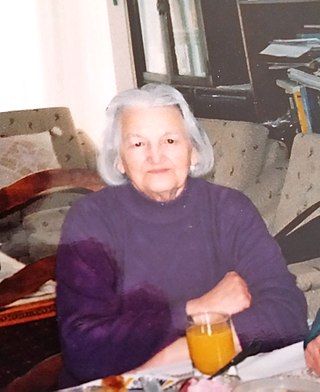
The Jedwabne pogrom was a massacre of Polish Jews in the town of Jedwabne, German-occupied Poland, on 10 July 1941, during World War II and the early stages of the Holocaust. Estimates of the number of victims vary from 300 to 1,600, including women, children, and elderly, many of whom were locked in a barn and burned alive.
Marek Jan Chodakiewicz is a Polish-American historian specializing in Central European history of the 19th and 20th centuries. He teaches at the Patrick Henry College and at the Institute of World Politics. He has been described as conservative and nationalistic, and his attitude towards minorities has been widely criticized.

The Crveni Krst concentration camp, also known as the Niš concentration camp, located in Crveni Krst, Niš, was operated by the German Gestapo and used to hold captured Serbs, Jews and Romanis during the Second World War. Established in mid-1941, it was used to detain as many as 35,000 people during the war and was liberated by the Yugoslav Partisans in 1944. More than 10,000 people are thought to have been killed at the camp. After the war, a memorial to the victims of the camp was erected on Mount Bubanj, where many inmates were shot. A memorial museum was opened on the former campgrounds in 1967 and in 1979 the campgrounds were declared a Cultural Monument of Exceptional Importance and came under the protection of the Socialist Republic of Serbia.

Ryszard Janusz Bender was a Polish right-wing politician and historian. He is noted for his characterization of Auschwitz as a "labour camp", attracting allegations of Holocaust denial.

Kaniūkai is a village in the Šalčininkai district municipality of Lithuania. According to the 2011 census, its population was 125.
Joanna Beata Michlic is a Polish social and cultural historian specializing in Polish-Jewish history and the Holocaust in Poland. An honorary senior research associate at the Centre for Collective Violence, Holocaust and Genocide Studies at University College London (UCL), she focuses in particular on the collective memory of traumatic events, particularly as it relates to gender and childhood.
The anti-Jewish violence in Central and Eastern Europe following the retreat of Nazi German occupational forces and the arrival of the Soviet Red Army – during the latter stages of World War II – was linked in part to postwar anarchy and economic chaos exacerbated by the Stalinist policies imposed across the territories of expanded Soviet republics and new satellite countries. The anti-semitic attacks had become frequent in Soviet towns ravaged by war; at the marketplaces, in depleted stores, in schools, and even at state enterprises. Protest letters were sent to Moscow from numerous Russian, Ukrainian and Belarusian towns by the Jewish Anti-Fascist Committee involved in documenting the Holocaust.

Vasil Zacharka was a Belarusian statesman and the second president of the Belarusian People's Republic in exile.

John-Paul Himka is an American-Canadian historian and retired professor of history of the University of Alberta in Edmonton. Himka received his BA in Byzantine-Slavonic Studies and Ph.D. in History from the University of Michigan in 1971 and 1977 respectively. The title of his Ph.D. dissertation was Polish and Ukrainian Socialism: Austria, 1867–1890. As a historian Himka was a Marxist in the 1970s–80s, but became influenced by postmodernism in the 1990s. In 2012 he defined his methodology in history as "eclectic".

Ivan Kamenec is a Slovak historian.

Jewish Motifs International Film Festival is a major Jewish-themed film festival held annually in Warsaw, Poland. The festival has been held every year since 2004.
Daniel Romanovsky was an Israeli historian and researcher who has contributed to the study of the Holocaust in the Soviet Union under German occupation in World War II. Romanovsky was a Soviet refusenik politically active since the 1970s. Private seminars on the history of the Jews were held in his Leningrad apartment in the 1980s. Research on the topic was difficult in the Soviet Union because of government restrictions. In the 1970s and 1980s Romanovsky interviewed over 100 witnesses to the Holocaust, including Jews, Russians, and Belarusians, recording and cataloguing their accounts of the Final Solution.
Milan Stanislav Ďurica was a Slovak historian, Salesian priest and Catholic theologian.
Yevhen Nakonechny was a Ukrainian historian, librarian, library scientist, linguist, and a teenage prisoner of the Soviet Gulag forced labour camp system during postwar Stalinist period for his involvement with the Organization of Ukrainian Nationalists (OUN).

Đakovo was an internment camp for Jewish, and to a lesser extent Serb, women and children in the town of Đakovo in the Independent State of Croatia (NDH) that was operational between December 1941 and July 1942, during World War II.

Haim Estreya Ovadya was a Jewish partisan from Bitola who joined the Yugoslav Partisans after the German invasion of Yugoslavia in 1941 during World War II. She was posthumously proclaimed People's Hero of Yugoslavia.
The historiography of the Holocaust in Slovakia has been a much-debated subject, and historians have still not arrived at a consensus position as to the role of the Slovak State in the Holocaust.

Žamila Andžela Kolonomos was a Sephardi Jewish partisan, writer, academic, and political activist in what is now North Macedonia.

Jüri Lina is an Estonian journalist, writer, paranormal investigator, music producer, radio host, film director and ufologist.

Generalbezirk Weißruthenien was one of the four administrative subdivisions of Reichskommissariat Ostland, the 1941–1945 civilian occupation regime established by Nazi Germany for the administration of the three Baltic countries and the western part of the Byelorussian SSR.













